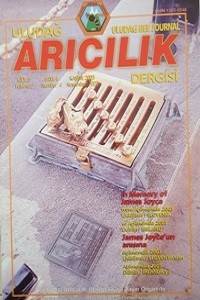Abstract
This study was carried out to investigate the effect of propolis ethanolic extracts (5%, PEE) with different inclusions in the diet (0, 6, 12 cc PEE kg-1) on the growth performance and slaughter traits of Japanese quails (Coturnix coturnix japonica). Experimental animals were 1-d old mixed sex Japanese quails weighing 10.1±0.1 g per bird. Birds were divided into 3 groups with 2 replications in each, ie., 22 birds in each sub-group. During experiment, birds’ body weights and their feed intakes were recorded weekly to calculate feed conversion ratio, g feed intake: g gain. At the end of experiment, 6 birds (3 males and 3 females) from each subgroup were killed for determination of slaughter traits. At the age of 35-d old, final live weight were 250.3 g in control, 247.2 g in 6 cc PEE, 256.7 g in 12 cc PEE group without no statistical significance (P>0.05). Feed conversion ratios were 3.01, 3.15 and 3.17 in these treatment groups respectively (P>0.05). With respect to dressing out percentage, 12 cc PEE consumed group (75.7 %) were higher than the other groups control and 6 cc PEE groups (73.3 % vs 73.1 %) (P<0.05). Also, liveability rate of quails was increased evidently about 5-8 % by PEE treatments without any statistical significance. To conclude, the inclusion of propolis extracts did not affect the growth performance of quails and slaughter traits except dressing out percentage. However, the effect of propolis on liveability needs to be take consideration with more detailed experimental design.
References
- Burdock, G.A. 1998. Review of biological properties and toxicity of bee propolis (propolis). Food and Chemical toxicology 36:347-363
- Castaldo, S., Capasso, F. 2002. Propolis, an old remedy used in modern medicine. Fitoterapia 73 (Suppl 1):S1-S6
- Kartal, M., Yıldız, S., Kaya, S., Kurucu, S., Topçu, G.2003. Antimicrobial activity of propolis samples from different regions of Anatolia. Journal of Ethnopharmacology 2860:1-5
- Nagai, T., Sakai, M., Inoue, R., Inoue, H., Suzuki, N.2001. Antioxidative activities of some commercially honeys, royal jelly and propolis. Food Chemistry 75:237-240
- Orsolic, N., Basic, I.2003. Immunomodulation by watersoluble derivative of propolis: a factor of antitumor reactivity. Journal of Ethnopharmacology 84 :265-273
- Sarıca, M., Camcı, Ö., Selçuk, E.1998. Bıldırcın, sülün, keklik, etçi güvercin ve devekuşu yetiştiriciliği. OMU Ziraat Fakültesi Ders Kitabı, No:10. 2. Baskı.
- Tolon, B., Önenç, A., Kaya, A., Altan, O.2002. Effects of propolis on growth of calves. First German Bee Product and Apitherapy Congress, 23-24 March 2002, Germany.
Abstract
Bu çalışma, karma yeme farklı konsantrasyonlarda katılan (0, 6, 12 cc kg-1) %5’lik propolisin etanolik ekstratının (PEE) japon bıldırcınlarında (Coturnix coturnix japonica) besi performansı ve karkas özelliklerine etkilerini araştırmak amacı ile yapılmıştır. Hayvan materyali olarak, 1 günlük yaşta karışık cinsiyetli (10.1 ± 0.1 g civciv-1) bıldırcınlar kullanılmıştır. Araştırmada her grupta 2 tekerrür ve her tekerrürde 22 hayvan olacak şekilde 6 grup oluşturulmuştur. Deneme süresince her hafta canlı ağırlıklar bireysel olarak, yem tüketimleri ise grup düzeyinde alınmış ve bu değerlerden yararlanarak yemden yararlanma oranları hesaplanmıştır. Deneme sonunda (35.günde) her gruptan 3 dişi ve 3 erkek kesilerek karkas özellikleri belirlenmiştir. 35 günlük yaşta en yüksek canlı ağırlık 256.7 g ile 12 cc PEE kg-1 katkılı gruptan elde edilmiş ve bunu 250.3 g canlı ağırlık ile kontrol grubu ve 247.2 g ile 6 cc PEE kg-1 katkılı grup izlemiş olup, fakat bu farklılıklar istatistiki olarak önemsiz bulunmuştur (P>0.05). Grupların yemden yararlanma oranları 0,6 ve 12 cc PEE kg-1 katkılı gruplarda sırasıyla, 3.01, 3.15 ve 3.17 olarak hesaplanmıştır (P>0.05). Deneme sonunda, en yüksek karkas randımanı değeri %75.7 ile 12 cc PEE kg-1 katkılı gruptan elde edilmiş ve bu grup diğer gruplardan (kontrol, % 73.3 ve 6 cc PEE; %73.1) istatistiki farklılık göstermiştir (P<0.05). Ayrıca, propolis katkısı yaklaşık %5-8 oranında bıldırcınlarda yaşama gücünü arttırmıştır (P>0.05). Sonuç olarak, bıldırcın karma yemlerine propolis katkısının besi performansı ve kesim özelliklerine karkas randımanı dışında etkisi olmamasına rağmen, yaşama gücünü arttırıcı etkisi daha detaylı deneme modeli ve metodlarla araştırılmalıdır
References
- Burdock, G.A. 1998. Review of biological properties and toxicity of bee propolis (propolis). Food and Chemical toxicology 36:347-363
- Castaldo, S., Capasso, F. 2002. Propolis, an old remedy used in modern medicine. Fitoterapia 73 (Suppl 1):S1-S6
- Kartal, M., Yıldız, S., Kaya, S., Kurucu, S., Topçu, G.2003. Antimicrobial activity of propolis samples from different regions of Anatolia. Journal of Ethnopharmacology 2860:1-5
- Nagai, T., Sakai, M., Inoue, R., Inoue, H., Suzuki, N.2001. Antioxidative activities of some commercially honeys, royal jelly and propolis. Food Chemistry 75:237-240
- Orsolic, N., Basic, I.2003. Immunomodulation by watersoluble derivative of propolis: a factor of antitumor reactivity. Journal of Ethnopharmacology 84 :265-273
- Sarıca, M., Camcı, Ö., Selçuk, E.1998. Bıldırcın, sülün, keklik, etçi güvercin ve devekuşu yetiştiriciliği. OMU Ziraat Fakültesi Ders Kitabı, No:10. 2. Baskı.
- Tolon, B., Önenç, A., Kaya, A., Altan, O.2002. Effects of propolis on growth of calves. First German Bee Product and Apitherapy Congress, 23-24 March 2002, Germany.
Details
| Primary Language | Turkish |
|---|---|
| Subjects | Structural Biology |
| Journal Section | Research Articles |
| Authors | |
| Publication Date | November 25, 2003 |
| Published in Issue | Year 2003 Volume: 03 Issue: 4 |
Important Note: Since the author-referee information is kept confidential on both sides in our journal, both the author and the referees must upload the document to the system after removing their personal information in the review document section.
Note: Authors can also use homepage of our Journal.
https://creativecommons.org/licenses/by-nc-nd/4.0/
This work is licensed under Attribution-NonCommercial-NoDerivatives 4.0 International.


